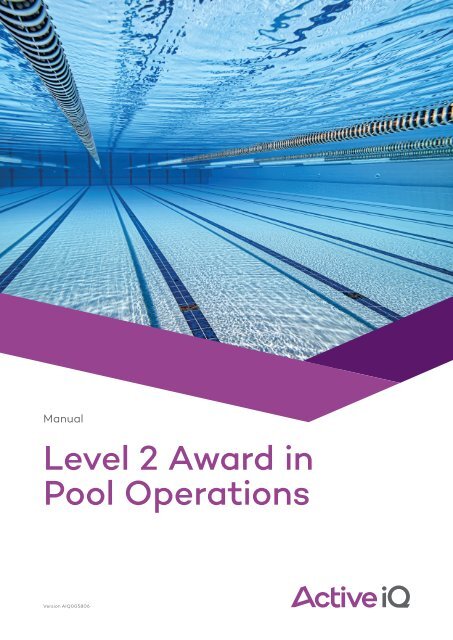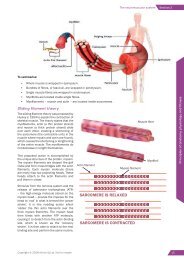Active IQ Level 2 Award in Pool Operations (sample manual)
For more information, please visit https://www.activeiq.co.uk/qualifications/level-2/active-iq-level-2-award-in-pool-operations
For more information, please visit https://www.activeiq.co.uk/qualifications/level-2/active-iq-level-2-award-in-pool-operations
You also want an ePaper? Increase the reach of your titles
YUMPU automatically turns print PDFs into web optimized ePapers that Google loves.
Manual<br />
<strong>Level</strong> 2 <strong>Award</strong> <strong>in</strong><br />
<strong>Pool</strong> <strong>Operations</strong><br />
Version A<strong>IQ</strong>005806
The pr<strong>in</strong>ciples and practice<br />
of pool water treatment<br />
and test<strong>in</strong>g<br />
Aim<br />
This unit provides an overview of the responsibilities held by pool operators to ensure the environment is safe for<br />
staff and visitors. The different types of pool that operators may come across are discussed, along with the various<br />
models of pool ownership and recommended temperatures for these different types. An understand<strong>in</strong>g of the<br />
importance of good cleanl<strong>in</strong>ess and hygiene is essential for a pool operator, as well as know<strong>in</strong>g the causes of water<br />
pollution and how a pool’s water circulation system works to keep that pollution to a m<strong>in</strong>imum.<br />
A key responsibility of pool operators is that they know how to test pool water, and so a further focus of this unit<br />
is the tests used to ensure optimum pool water quality, how to carry out the tests properly, and to understand the<br />
importance of accurate record keep<strong>in</strong>g.<br />
Learn<strong>in</strong>g outcomes<br />
At the end of this unit you will:<br />
• Understand the legal responsibilities of pool operators to provide a safe pool environment<br />
• Understand the types of pools and pool ownership<br />
• Understand the causes of pool water pollution and contam<strong>in</strong>ation<br />
• Understand the importance of good bather hygiene prior to the use of pools<br />
• Understand the importance of good standards of cleanl<strong>in</strong>ess <strong>in</strong> the swimm<strong>in</strong>g pool environment<br />
• Understand the operat<strong>in</strong>g pr<strong>in</strong>ciples of a simple pool water circulation system<br />
• Know the recommended temperatures for the types of pools used <strong>in</strong> active leisure facilities<br />
• Understand how pool operators provide a safe pool environment<br />
• Know the essential tests to ensure optimum pool water quality<br />
• Understand the different types of pool water test<strong>in</strong>g equipment<br />
needed to ensure good quality pool water<br />
• Demonstrate correct pool water test<strong>in</strong>g techniques<br />
• Understand the importance of accurate record keep<strong>in</strong>g<br />
Copyright © 2019 <strong>Active</strong> <strong>IQ</strong> Ltd. Not for resale<br />
1
Different types of pools and pool ownership<br />
Section 2<br />
Section 2: Different types of<br />
pools and pool ownership<br />
The range of pools used with<strong>in</strong> the active leisure sector <strong>in</strong>cludes:<br />
• Competition pools<br />
• Leisure pools (<strong>in</strong>corporat<strong>in</strong>g water features)<br />
• Outdoor pools<br />
• Div<strong>in</strong>g pits<br />
• Shallow water pools<br />
• Spa pools<br />
• Hydrotherapy pools<br />
• Interactive water features<br />
The ma<strong>in</strong> purposes of the pools used <strong>in</strong> the active leisure sector are summarised <strong>in</strong> table 2.1.<br />
Type of pool<br />
Purpose/description<br />
Swimm<strong>in</strong>g pools • Competitive swimm<strong>in</strong>g and div<strong>in</strong>g<br />
Recreational swimm<strong>in</strong>g pools and conventional ma<strong>in</strong><br />
pools<br />
• Fitness swimm<strong>in</strong>g<br />
• Tra<strong>in</strong><strong>in</strong>g<br />
• Recreation<br />
• Adult teach<strong>in</strong>g<br />
Leisure pools • Enjoyment<br />
• Water-based play<br />
<strong>Pool</strong>s operat<strong>in</strong>g at slightly higher temperatures • Children’s teach<strong>in</strong>g<br />
• Used by babies, young children and those with<br />
a disability<br />
Hydrotherapy pools • Found <strong>in</strong> schools, hospitals and hospices<br />
Spa pools • Relaxation<br />
• Aquatic therapy, physiotherapy, etc<br />
• These pools operate at higher temperatures<br />
than other pools<br />
• Found <strong>in</strong> many locations, <strong>in</strong>clud<strong>in</strong>g hotels and<br />
fitness clubs<br />
Hot tubs • Domestic spa pools used for relaxation<br />
• Often found <strong>in</strong> holiday and lodge parks<br />
Counter-current/exercise pools • Small pools with a mechanically derived current<br />
aga<strong>in</strong>st which users can swim<br />
Birth<strong>in</strong>g pools • Small pools <strong>in</strong> which women can choose to<br />
give birth<br />
• Subject to strong bacteriological control<br />
Hotel pools • Used by hotel guests and club members<br />
Paddl<strong>in</strong>g pools • Outdoor paddl<strong>in</strong>g pools of shallow water<br />
Plunge pools • Used for cool<strong>in</strong>g down after exercise<br />
School pools • Often smaller pools used for swimm<strong>in</strong>g lessons<br />
• Sometimes used by community and other groups<br />
at even<strong>in</strong>gs and weekends<br />
The pr<strong>in</strong>ciples and practice of pool water treatment and test<strong>in</strong>g<br />
Table 2.1 Ma<strong>in</strong> types of pool and their purposes<br />
Copyright © 2019 <strong>Active</strong> <strong>IQ</strong> Ltd. Not for resale 7
<strong>Pool</strong> water pollution<br />
Section 3<br />
Section 3: <strong>Pool</strong> water pollution<br />
It is important that the pool operator understands the causes of pool water pollution and contam<strong>in</strong>ation, and the<br />
role that the plant plays <strong>in</strong> deal<strong>in</strong>g with or remov<strong>in</strong>g them. The causes of pool water pollution can be separated <strong>in</strong>to<br />
three categories:<br />
• Physical pollutants<br />
• Chemical pollutants<br />
• Biological pollutants<br />
The common denom<strong>in</strong>ator for all these forms of pollution is the bathers themselves.<br />
Pollution added by bathers<br />
Bathers <strong>in</strong>troduce all three types of pollution to the pool water: physical, chemical and biological. Each day, an<br />
adult produces 1 litre of sweat, 1 billion sk<strong>in</strong> fl akes and 38g of grease (SPW). It is also estimated that each bather<br />
releases approximately 30ml of ur<strong>in</strong>e and 200mg of urea <strong>in</strong> a typical swim session. When a bather is exercis<strong>in</strong>g,<br />
they also release a signifi cant amount of sweat; this <strong>in</strong>creases <strong>in</strong> l<strong>in</strong>e with pool water temperature.<br />
In addition, the human body carries numerous chemicals <strong>in</strong> the form of cosmetics, deodorants, powders, creams,<br />
lotions, oils, etc, all of which add further pollution to the water.<br />
Outdoor pools<br />
Outdoor pools, especially those found <strong>in</strong> warm climates, experience signifi cant problems caused by suntan lotion<br />
and sweat added by the bathers, as well as environmental pollution from sand, leaves, grass, soil, etc.<br />
Types of pollution<br />
The types of pollution can be further classifi ed as:<br />
• Surface pollution<br />
• Dissolved pollution<br />
• Suspended pollution<br />
• Insoluble pollution<br />
They can be found <strong>in</strong> various places <strong>in</strong> the pool itself (as illustrated <strong>in</strong> fi gure 3.1).<br />
Dissolved pollution<br />
Surface pollution<br />
The pr<strong>in</strong>ciples and practice of pool water treatment and test<strong>in</strong>g<br />
Suspended pollution<br />
Insoluble pollution<br />
Figure 3.1 Pollution distribution<br />
Copyright © 2019 <strong>Active</strong> <strong>IQ</strong> Ltd. Not for resale 11
Section 4<br />
The importance of good bather hygiene prior to pool use<br />
Po<strong>in</strong>t 1: Chang<strong>in</strong>g room floors must be kept clean<br />
by regular scrubb<strong>in</strong>g and mopp<strong>in</strong>g.<br />
Po<strong>in</strong>t 2: Bathers should be encouraged to use the<br />
toilets prior to swimm<strong>in</strong>g.<br />
Po<strong>in</strong>t 3: All bathers must be encouraged to<br />
shower prior to swimm<strong>in</strong>g <strong>in</strong> order to remove<br />
bacteria, sweat, cosmetics, etc.<br />
Po<strong>in</strong>t 4: Avoid poolside contam<strong>in</strong>ation by<br />
encourag<strong>in</strong>g the use of overshoes. <strong>Pool</strong> surrounds<br />
should be thoroughly scrubbed.<br />
Figure 4.1 The four-po<strong>in</strong>t plan for good pool hygiene<br />
16<br />
Copyright © 2019 <strong>Active</strong> <strong>IQ</strong> Ltd. Not for resale
The pool water circulation system<br />
Section 6<br />
Section 6: The pool water<br />
circulation system<br />
In order for swimm<strong>in</strong>g pool water to stay safe and clear, it needs to flow through a series of processes (see figure 6.1).<br />
Figure 6.1 Schematic pool circulation (hypochlorite dis<strong>in</strong>fectant: no UV)<br />
ACID INJECTION<br />
POINT<br />
POOL<br />
BALANCE<br />
TANK<br />
HEAT EXCHANGER<br />
(CALORIFIER)<br />
SIGHT GLASS<br />
TO DRAIN<br />
HYPOCHLORITE INJECTION<br />
POINT<br />
FILTER<br />
FILTER<br />
TO DRAIN<br />
COAGULANT/<br />
FLOCCULANT<br />
INJECTION<br />
POINT<br />
BACK WASH<br />
FLOW METER<br />
SIGHT GLASS<br />
STRAINER<br />
CIRCULATING<br />
PUMPS<br />
SAMPLE POINT<br />
TO DOSING UNIT<br />
A surface draw-off system removes the surface water, and<br />
water leaves the bottom of the pool through sump outlets.<br />
In deck level pools, the water is then fed <strong>in</strong>to a balance tank.<br />
The balance tank (figure 6.2) accommodates the water<br />
displaced by bathers. The balance tank also provides<br />
a means of <strong>in</strong>troduc<strong>in</strong>g water <strong>in</strong>to the system to replace<br />
water used to wash the filters.<br />
The pr<strong>in</strong>ciples and practice of pool water treatment and test<strong>in</strong>g<br />
Figure 6.2 A balance tank<br />
Copyright © 2019 <strong>Active</strong> <strong>IQ</strong> Ltd. Not for resale 21
Section 9<br />
The essential tests to ensure optimum pool water quality<br />
The comparator<br />
The traditional method of pool water test<strong>in</strong>g for pH and chlor<strong>in</strong>e uses a comparator. This is a very simple piece<br />
of equipment where the test <strong>sample</strong> conta<strong>in</strong><strong>in</strong>g the reagent dye is compared aga<strong>in</strong>st a circular disc of different<br />
coloured pieces of glass.<br />
Ideally, the comparator should be fitted with a portable back-light which provides good quality white light to<br />
accentuate the colours, or it should be viewed aga<strong>in</strong>st a bench-mounted white light source.<br />
Figure 9.2 A comparator<br />
The comparator should be used with the disc appropriate to the test be<strong>in</strong>g carried out: a pH disc (phenol red), a<br />
chlor<strong>in</strong>e disc or a disc which measures brom<strong>in</strong>e levels.<br />
If the comparator is viewed aga<strong>in</strong>st a white light source, a more accurate result will be given.<br />
Figure 9.3 Chlor<strong>in</strong>e, pH and brom<strong>in</strong>e discs<br />
Us<strong>in</strong>g a comparator to measure pH<br />
1<br />
Select<br />
2<br />
Add<br />
3<br />
Take<br />
4<br />
Insert<br />
5<br />
Revolve<br />
the phenol red disc and <strong>in</strong>sert it <strong>in</strong>to the comparator. Ensure it is <strong>in</strong>stalled the correct<br />
way, with the numbers <strong>in</strong> the right hand corner of the comparator.<br />
a 10ml <strong>sample</strong> of water to the left hand test tube.<br />
a second clean test tube conta<strong>in</strong><strong>in</strong>g 10ml of water and crush a phenol red tablet <strong>in</strong>to it.<br />
the test tube conta<strong>in</strong><strong>in</strong>g the phenol red dye <strong>in</strong>to the right hand side of the comparator.<br />
the comparator disc until the colours match. The read<strong>in</strong>g can be found <strong>in</strong> the bottom<br />
right hand w<strong>in</strong>dow of the comparator.<br />
36<br />
Copyright © 2019 <strong>Active</strong> <strong>IQ</strong> Ltd. Not for resale
Section 9<br />
The essential tests to ensure optimum pool water quality<br />
Typical procedure<br />
1 Switch the photometer on us<strong>in</strong>g the on/off key.<br />
2<br />
Select the appropriate mode (e.g. free chlor<strong>in</strong>e or pH) by press<strong>in</strong>g the mode key or the appropriate button<br />
on the keypad.<br />
3<br />
4<br />
5<br />
Fill a clean test cell with 10ml of test water, align<strong>in</strong>g the triangles on the test tube with those on the<br />
photometer, and press the zero/test key.<br />
Add the appropriate reagent tablet (e.g. phenol red to measure pH).<br />
Crush the tablet and make sure it has properly dissolved; screw the cap back on.<br />
6 Place the test cell <strong>in</strong> the test compartment, once aga<strong>in</strong> align<strong>in</strong>g the triangles, and press the zero/test key.<br />
7<br />
8<br />
The method symbol will then flash and the result will appear <strong>in</strong> the display panel.<br />
Remember to repeat the zero<strong>in</strong>g process <strong>in</strong> between each test.<br />
A photometer will only measure with<strong>in</strong> its <strong>in</strong>dividual range, so if the <strong>sample</strong> is either below or above this range, an<br />
error message will be generated. If it is above range, it will be necessary to carry out dilution of the <strong>sample</strong> until the<br />
<strong>sample</strong> comes back with<strong>in</strong> the range of the <strong>in</strong>strument.<br />
When measur<strong>in</strong>g chlor<strong>in</strong>e levels us<strong>in</strong>g a photometer, the pr<strong>in</strong>ciple of dissolv<strong>in</strong>g the DPD 1 <strong>in</strong>to two drops of water<br />
and then mak<strong>in</strong>g it up to 10ml should also be followed, and it is still necessary for the operator to leave two m<strong>in</strong>utes<br />
for the chemical reaction to take place between the DPD 1 and DPD 3 <strong>in</strong> order to establish the total chlor<strong>in</strong>e read<strong>in</strong>g<br />
from which the comb<strong>in</strong>ed chlor<strong>in</strong>e level is derived.<br />
Newer photometers have a built-<strong>in</strong> timer which will count down<br />
from two m<strong>in</strong>utes when the operator <strong>in</strong>dicates that they are<br />
work<strong>in</strong>g out a total chlor<strong>in</strong>e read<strong>in</strong>g.<br />
Where the water has a high calcium content, it may be<br />
necessary to use DPD 1 high calcium tablets.<br />
Photometers are precision <strong>in</strong>struments but they must be<br />
checked aga<strong>in</strong>st calibration standards to ensure that they are<br />
properly calibrated. Some photometers have to be returned<br />
to the manufacturer for recalibration, whereas others can be<br />
recalibrated by the user.<br />
Cyanuric acid test<br />
Figure 9.6 Calibration standards<br />
If the pool is treated with ‘stabilised chlor<strong>in</strong>e’ (i.e. chlor<strong>in</strong>e that conta<strong>in</strong>s cyanuric acid, e.g. trichlor), it is also<br />
necessary for the cyanuric acid levels to be tested on a weekly basis. Most photometers will measure cyanuric acid<br />
levels; the typical procedure is followed, except that a cyanuric acid test reagent tablet is used. The recommended<br />
range for cyanuric acid is between 50 and 100mg/l. If the pool operator does not use a photometer, it is still<br />
possible to measure cyanuric acid levels us<strong>in</strong>g the turbidity test method.<br />
The turbidity tester consists of two plastic tubes: an <strong>in</strong>ner tube, which is graduated, and an outer tube, which has a<br />
water level <strong>in</strong>dicator. A cyanuric acid tablet is dissolved <strong>in</strong> the <strong>sample</strong>, and if there is any cyanuric acid present, the<br />
<strong>sample</strong> goes cloudy. The <strong>in</strong>ner tube is then pushed <strong>in</strong>to the outer tube until a black spot on the bottom of the <strong>in</strong>ner<br />
tube disappears. At this po<strong>in</strong>t, the read<strong>in</strong>g on the <strong>in</strong>ner tube at the <strong>in</strong>terface with the water is noted, and from this<br />
the cyanuric acid level can be determ<strong>in</strong>ed.<br />
38<br />
Copyright © 2019 <strong>Active</strong> <strong>IQ</strong> Ltd. Not for resale

















